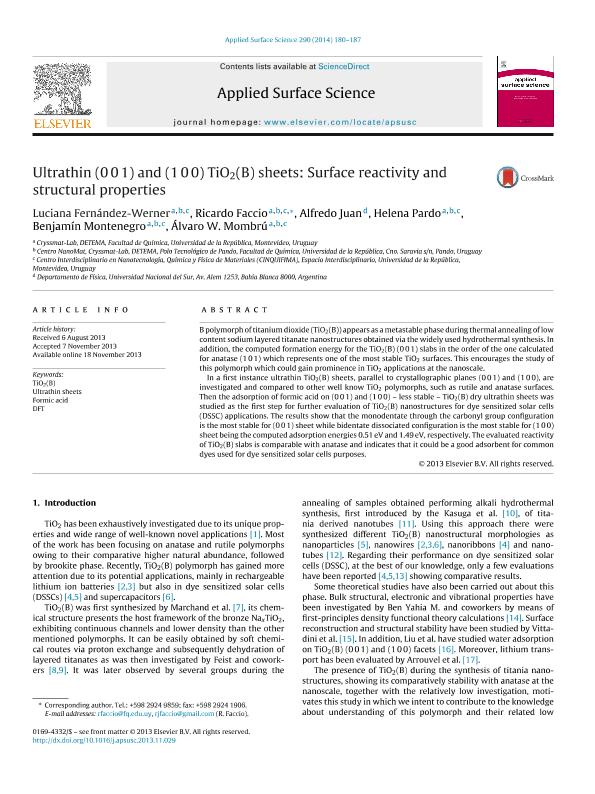Mostrar el registro sencillo del ítem
dc.contributor.author
Fernández Werner, Luciana

dc.contributor.author
Faccio, Ricardo
dc.contributor.author
Juan, Alfredo

dc.contributor.author
Pardo, Helena
dc.contributor.author
Montenegro, Benjamín
dc.contributor.author
Mombrú, Álvaro W.
dc.date.available
2017-12-05T18:34:51Z
dc.date.issued
2013-11
dc.identifier.citation
Fernández Werner, Luciana; Faccio, Ricardo; Juan, Alfredo; Pardo, Helena; Montenegro, Benjamín; et al.; Ultrathin (0 0 1) and (1 0 0) TiO2(B) sheets: surface reactivity and structural properties; Elsevier Science; Applied Surface Science; 290; 11-2013; 180-187
dc.identifier.issn
0169-4332
dc.identifier.uri
http://hdl.handle.net/11336/29766
dc.description.abstract
B polymorph of titanium dioxide (TiO2(B)) appears as a metastable phase during thermal annealing of low content sodium layered titanate nanostructures obtained via the widely used hydrothermal synthesis. In addition, the computed formation energy for the TiO2(B) (0 0 1) slabs in the order of the one calculated for anatase (1 0 1) which represents one of the most stable TiO2 surfaces. This encourages the study of this polymorph which could gain prominence in TiO2 applications at the nanoscale. In a first instance ultrathin TiO2(B) sheets, parallel to crystallographic planes (0 0 1) and (1 0 0), are investigated and compared to other well know TiO2 polymorphs, such as rutile and anatase surfaces. Then the adsorption of formic acid on (0 0 1) and (1 0 0) – less stable – TiO2(B) dry ultrathin sheets was studied as the first step for further evaluation of TiO2(B) nanostructures for dye sensitized solar cells (DSSC) applications. The results show that the monodentate through the carbonyl group configuration is the most stable for (0 0 1) sheet while bidentate dissociated configuration is the most stable for (1 0 0) sheet being the computed adsorption energies 0.51 eV and 1.49 eV, respectively. The evaluated reactivity of TiO2(B) slabs is comparable with anatase and indicates that it could be a good adsorbent for common dyes used for dye sensitized solar cells purposes.
dc.format
application/pdf
dc.language.iso
eng
dc.publisher
Elsevier Science

dc.rights
info:eu-repo/semantics/openAccess
dc.rights.uri
https://creativecommons.org/licenses/by-nc-nd/2.5/ar/
dc.subject
Formic Acid
dc.subject
Tio2
dc.subject.classification
Astronomía

dc.subject.classification
Ciencias Físicas

dc.subject.classification
CIENCIAS NATURALES Y EXACTAS

dc.title
Ultrathin (0 0 1) and (1 0 0) TiO2(B) sheets: surface reactivity and structural properties
dc.type
info:eu-repo/semantics/article
dc.type
info:ar-repo/semantics/artículo
dc.type
info:eu-repo/semantics/publishedVersion
dc.date.updated
2017-12-05T18:02:36Z
dc.journal.volume
290
dc.journal.pagination
180-187
dc.journal.pais
Países Bajos

dc.journal.ciudad
Amsterdam
dc.description.fil
Fil: Fernández Werner, Luciana. Universidad de la República; Uruguay
dc.description.fil
Fil: Faccio, Ricardo. Universidad de la República; Uruguay
dc.description.fil
Fil: Juan, Alfredo. Universidad Nacional del Sur. Departamento de Física; Argentina. Consejo Nacional de Investigaciones Científicas y Técnicas; Argentina
dc.description.fil
Fil: Pardo, Helena. Universidad de la República; Uruguay
dc.description.fil
Fil: Montenegro, Benjamín. Universidad de la República; Uruguay
dc.description.fil
Fil: Mombrú, Álvaro W.. Universidad de la República; Uruguay
dc.journal.title
Applied Surface Science

dc.relation.alternativeid
info:eu-repo/semantics/altIdentifier/doi/http://dx.doi.org/10.1016/j.apsusc.2013.11.029
dc.relation.alternativeid
info:eu-repo/semantics/altIdentifier/url/http://www.sciencedirect.com/science/article/pii/S0169433213021065
Archivos asociados
